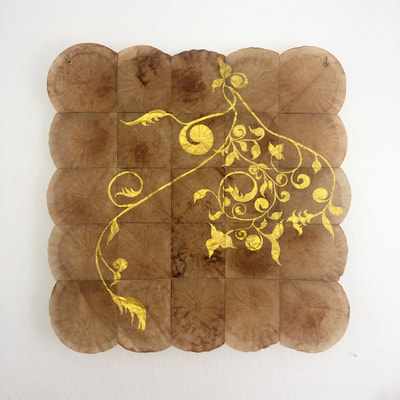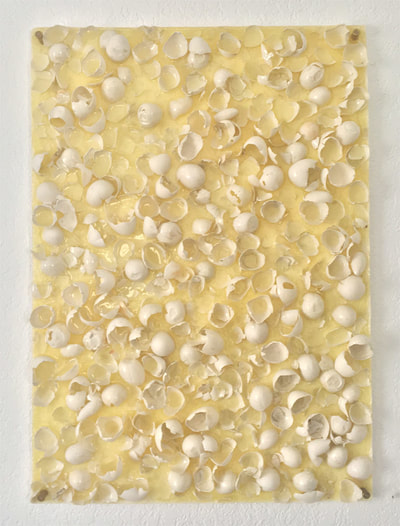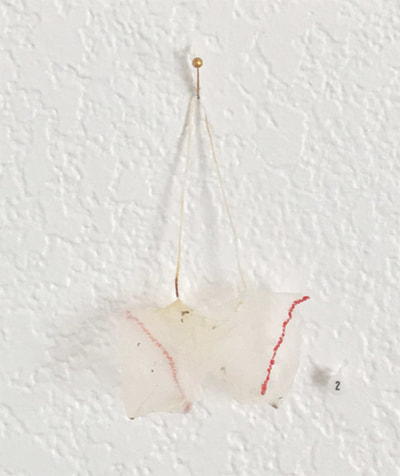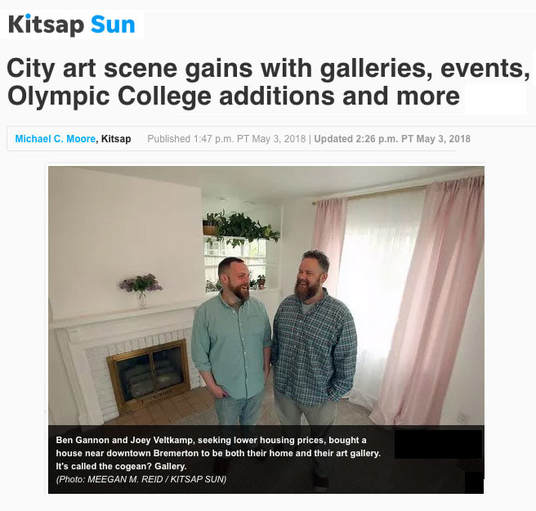|
RESIDUE
by Marie Weichman May 4th - June 16th, 2018 www.marieweichman.com "Residue is the stuff that is left behind after an action or use. Often it gets ignored and tossed away as if it had no value. But, what if we gave the residue we create more thought? What if turning the residue from one action, such as making tea, into another action such as making art became part of our daily activity? Would land fills shrink? Would imagination grow? What if? RESIDUE is an exhibition of artwork that explores the creative possibilities with the byproduct of my daily actions. I hope this show will inspire visitors to think before they toss, to find value in the side effect of human action and most of all reconnect with simply having fun with random stuff." - Marie Weichman Opening reception: Friday, May 4th, 2018, 6-9pm Brunch / informal artist discussion: Saturday, May 5th, 12:30-2:30pm |
YOUR VERY OWN CROWN, 2018, thread, used tea bags
Interview with Marie
April, 2018
cogean?: You previously mentioned that you had been thinking about a show about residue for the past decade. What makes now the right time?
Marie Weichman: The domestic setting of cogean? lends itself to issues of personal and private activities or routines such as making coffee or tea. It allows the visitors to connect with the artwork on a personal level rather than a commercial or public level. This personal experience is key to the content about residue and how we might become more aware of the byproduct of our own actions. I've never had the chance to merge the exhibition space with my artwork like I can at cogean? and that's what makes it the right time to do so. As they say... "context is everything!"
c?: Where do you seek inspiration?
MW: My work is influenced most by my love of exploration with random materials, textures and patinas that happen either by accident or intentionally, as well as patterns. Connecting these formal issues with content that speaks to the human experience can result in powerful outcomes. I love finding humor in mundane things, as well as discovering intense, impactful ways to connect with others through universally recognized objects using all of the senses. Mostly, I let exploration drive my decisions which is the most fun part of all.
c?: Can you talk about the use of multiples/repetition in your work?
MW: I started out using multiples/repetition in my work because I'm an identical twin. This led me to investigating questions of same-but-different. I realized quickly these questions could be applied to the greater community of social groups and cultures making my work more universally experienced. Repetition creates patterns and brings order to chaos which is one of my favorite formal elements. It allows me to get random and adventurous with the materials I choose and how I present the artwork. I don't think I could create artwork without using repetition in the design. It just goes against my gut instinct. Life is a series of patterns at an infinite level, and I'm addicted.
c?: How does teaching impact your practice?
MW: Teaching returns me to the foundation of what I do and why I do it. It keeps me relevant as the world moves forward to face new challenges. Teaching forces me to be confident and adventurous in my work, as well as articulate, and this allows me to communicate and share my professional experiences with my students and they can, in turn, influence the direction of my artwork in ways that remain current.
c?: What do you love about Bremerton?
MW: Bremerton has always been a creative community with a DIY spirit. It has a small town feel, but all the amenities of a larger city including an award winning college that just opened a new facility which houses the Arts and Health Occupations. This is important because technology is changing the world faster than most of us can adapt, and having a place to learn and exercise creative problem solving, collaboration, and compassionate care is needed now more than ever. "STEAM over STEM!" Olympic College and the city of Bremerton support this direction and are working to ensure there is a place for the creative class to live and work in a lifestyle that is enjoyable and contributes to the greater whole. It is a walkable community where anything is possible. Buy a house and turn it into an art gallery? SURE! Change an eye-sore retaining wall on a main street into a sanctioned FREE WALL for street artists? YES! Become a change-maker in the community? GO FOR IT! That's why I love Bremerton.
Marie Weichman: The domestic setting of cogean? lends itself to issues of personal and private activities or routines such as making coffee or tea. It allows the visitors to connect with the artwork on a personal level rather than a commercial or public level. This personal experience is key to the content about residue and how we might become more aware of the byproduct of our own actions. I've never had the chance to merge the exhibition space with my artwork like I can at cogean? and that's what makes it the right time to do so. As they say... "context is everything!"
c?: Where do you seek inspiration?
MW: My work is influenced most by my love of exploration with random materials, textures and patinas that happen either by accident or intentionally, as well as patterns. Connecting these formal issues with content that speaks to the human experience can result in powerful outcomes. I love finding humor in mundane things, as well as discovering intense, impactful ways to connect with others through universally recognized objects using all of the senses. Mostly, I let exploration drive my decisions which is the most fun part of all.
c?: Can you talk about the use of multiples/repetition in your work?
MW: I started out using multiples/repetition in my work because I'm an identical twin. This led me to investigating questions of same-but-different. I realized quickly these questions could be applied to the greater community of social groups and cultures making my work more universally experienced. Repetition creates patterns and brings order to chaos which is one of my favorite formal elements. It allows me to get random and adventurous with the materials I choose and how I present the artwork. I don't think I could create artwork without using repetition in the design. It just goes against my gut instinct. Life is a series of patterns at an infinite level, and I'm addicted.
c?: How does teaching impact your practice?
MW: Teaching returns me to the foundation of what I do and why I do it. It keeps me relevant as the world moves forward to face new challenges. Teaching forces me to be confident and adventurous in my work, as well as articulate, and this allows me to communicate and share my professional experiences with my students and they can, in turn, influence the direction of my artwork in ways that remain current.
c?: What do you love about Bremerton?
MW: Bremerton has always been a creative community with a DIY spirit. It has a small town feel, but all the amenities of a larger city including an award winning college that just opened a new facility which houses the Arts and Health Occupations. This is important because technology is changing the world faster than most of us can adapt, and having a place to learn and exercise creative problem solving, collaboration, and compassionate care is needed now more than ever. "STEAM over STEM!" Olympic College and the city of Bremerton support this direction and are working to ensure there is a place for the creative class to live and work in a lifestyle that is enjoyable and contributes to the greater whole. It is a walkable community where anything is possible. Buy a house and turn it into an art gallery? SURE! Change an eye-sore retaining wall on a main street into a sanctioned FREE WALL for street artists? YES! Become a change-maker in the community? GO FOR IT! That's why I love Bremerton.
Living with Marie Weichman's RESIDUE
June 2018
It's June, and wet. Then sunny, then wet. We put off our spring cleaning until after we wrapped up our goals for the garden in our back yard. We might have even gone a little overboard with two new cherry trees and thirteen roses finding homes in an empty parking strip with good light. But now having planted those trees and bushes, both our garden budget for the year, and our excuse to avoid addressing the nightmare happening in our garage are gone. And so we broke down all the boxes and bagged up all of the packaging, organizing like with like. Most of what we stuffed in this last space for us in our home to truly occupy is the remnants of our moving here, the generosity of our friends by way of our wedding registry, landscaping materials, and old artworks to big to store in the house. The remainders, leftovers and residues of the recent changes of our lives. And as we go through he process of tidying up, which is really most difficult because it is so full of decisions, we can’t help but be moved by the artistic spirit (part magpie/part beaver) to wonder what things we could create with these leftover materials.
Upstairs and in the opposite corner of the house from the garage, this question about leftovers is formally asked and answered by Marie Weichman's installation RESIDUE for cogean? to subtle, warm and beautiful effect.
On one wall, within in a double circle of perfectly placed pins, hangs a meticulously constructed crown made of used tea bags. Bound together at the center with red thread, the long strands dangling from the crown evoke menstruation and birth. On the same wall, to the left of the crown, is pinned a smaller piece: two silk tea bags, emptied of their contents and then sewn back together, their steeping threads then tied together. Lightly they hang from the pin like ghostly testicles.
Grouped on the shelves that separate the gallery space from our kitchen, so at home in the space that they may be confused for possessions, are a series of seductively glazed mugs with satisfyingly delicate edges but substantial proportion, all stamped with a spiral, floral motif. Next to the mugs and hanging above the mantle this same motif, a motif from a tattoo on Marie's body, is painted in gold on a large field of delicate browns and beiges. Used coffee filters patched together, hanging from two tiny gold grommets, so light that it responds whenever you walk by it, its gold flourish responding as well to the shift in light.
Brimming and cascading out of all the shelves in the bookcase and on to the fireplace and mantel, picking up the gold tone from the painting over the mantle with their yellow paint, are hundreds of slip cast honey bears. Originally made for an exhibition a decade ago, they are born anew in their reemergence in a different context.
In the second room of the gallery, on a low white plinth in the center of the room, centered on the south facing window, sits a bent-wire sculpture, clearly once and distinctly no longer a vital component of something or another, but now warped and folded into art. On the wall to the west of the sculpture hang three works: a mixed media 'landscape' on a wooden board, a drawing on cardboard, and a rectangular piece of resin holding together slipcast egg shells. To the west, a collection of prints of animals, works Marie may be best known for in our town.
All of these layers of past and present, new works and old come together and feel so at home in the space. In their colors and textures, subjects and materials they are camouflaged in the domestic space, blending in with our daily lives. And yet at the same time pushing us to think anew about the possibilities of the mundane and overlooked materials and possibilities in our lives.
What does it look like to care for what is left over? Not only the physical leftovers from creation processes like making a pot of coffee or a collection of ceramic pieces for an art show, but also the ways of being and knowing ourselves that, while still true, are true because they existed once but have transformed into something new over time and through space? How do we artfully integrate the past with the present? It is something like the way that Marie's show, like herself, is bold, experimental, confident and kind.
Upstairs and in the opposite corner of the house from the garage, this question about leftovers is formally asked and answered by Marie Weichman's installation RESIDUE for cogean? to subtle, warm and beautiful effect.
On one wall, within in a double circle of perfectly placed pins, hangs a meticulously constructed crown made of used tea bags. Bound together at the center with red thread, the long strands dangling from the crown evoke menstruation and birth. On the same wall, to the left of the crown, is pinned a smaller piece: two silk tea bags, emptied of their contents and then sewn back together, their steeping threads then tied together. Lightly they hang from the pin like ghostly testicles.
Grouped on the shelves that separate the gallery space from our kitchen, so at home in the space that they may be confused for possessions, are a series of seductively glazed mugs with satisfyingly delicate edges but substantial proportion, all stamped with a spiral, floral motif. Next to the mugs and hanging above the mantle this same motif, a motif from a tattoo on Marie's body, is painted in gold on a large field of delicate browns and beiges. Used coffee filters patched together, hanging from two tiny gold grommets, so light that it responds whenever you walk by it, its gold flourish responding as well to the shift in light.
Brimming and cascading out of all the shelves in the bookcase and on to the fireplace and mantel, picking up the gold tone from the painting over the mantle with their yellow paint, are hundreds of slip cast honey bears. Originally made for an exhibition a decade ago, they are born anew in their reemergence in a different context.
In the second room of the gallery, on a low white plinth in the center of the room, centered on the south facing window, sits a bent-wire sculpture, clearly once and distinctly no longer a vital component of something or another, but now warped and folded into art. On the wall to the west of the sculpture hang three works: a mixed media 'landscape' on a wooden board, a drawing on cardboard, and a rectangular piece of resin holding together slipcast egg shells. To the west, a collection of prints of animals, works Marie may be best known for in our town.
All of these layers of past and present, new works and old come together and feel so at home in the space. In their colors and textures, subjects and materials they are camouflaged in the domestic space, blending in with our daily lives. And yet at the same time pushing us to think anew about the possibilities of the mundane and overlooked materials and possibilities in our lives.
What does it look like to care for what is left over? Not only the physical leftovers from creation processes like making a pot of coffee or a collection of ceramic pieces for an art show, but also the ways of being and knowing ourselves that, while still true, are true because they existed once but have transformed into something new over time and through space? How do we artfully integrate the past with the present? It is something like the way that Marie's show, like herself, is bold, experimental, confident and kind.
City art scene gains with galleries, events, Olympic College additions... /May 3rd, 2018
Kitsap Sun / Michael C. Moore
""There's definitely something happening here," said one of them, Marie Weichman, a member of the art faculty at Olympic College. "You can feel it coming from a lot of different places, and it all seems to be coming together."
Kitsap Sun / Michael C. Moore
""There's definitely something happening here," said one of them, Marie Weichman, a member of the art faculty at Olympic College. "You can feel it coming from a lot of different places, and it all seems to be coming together."













